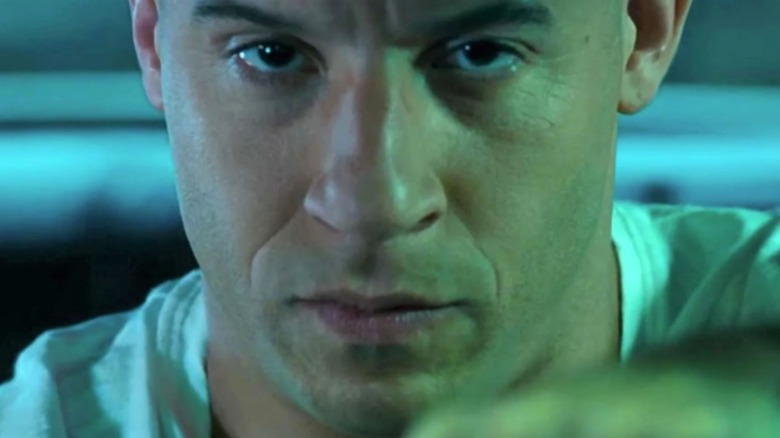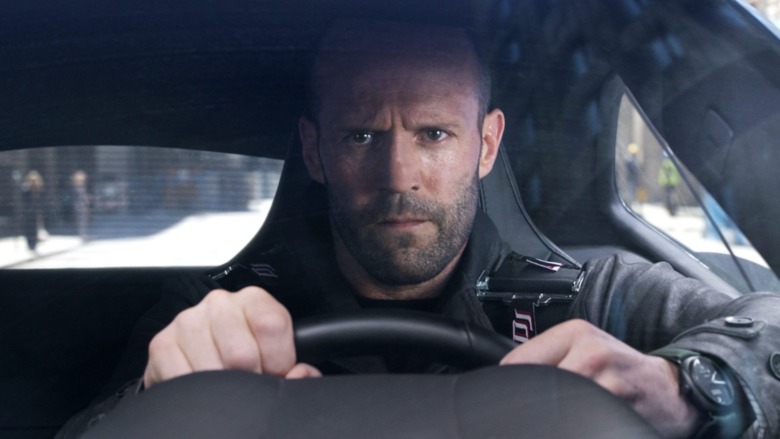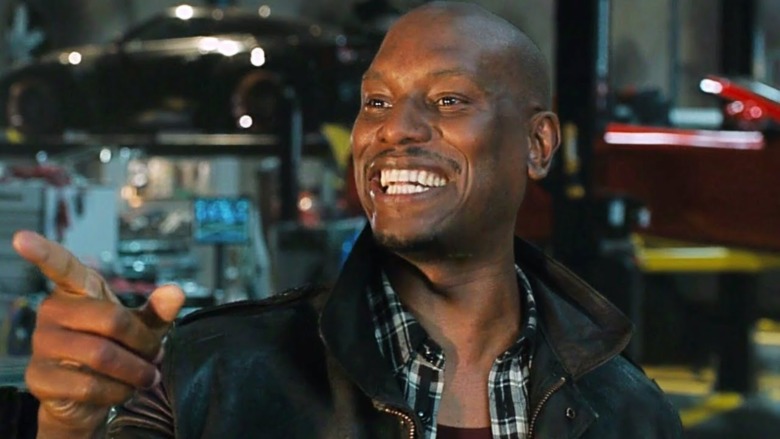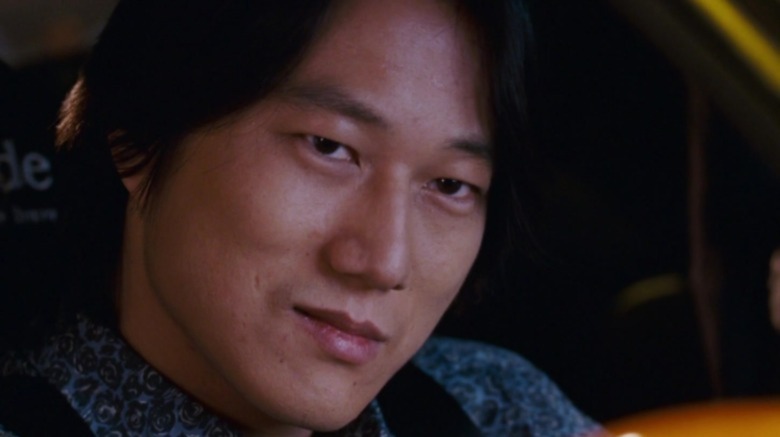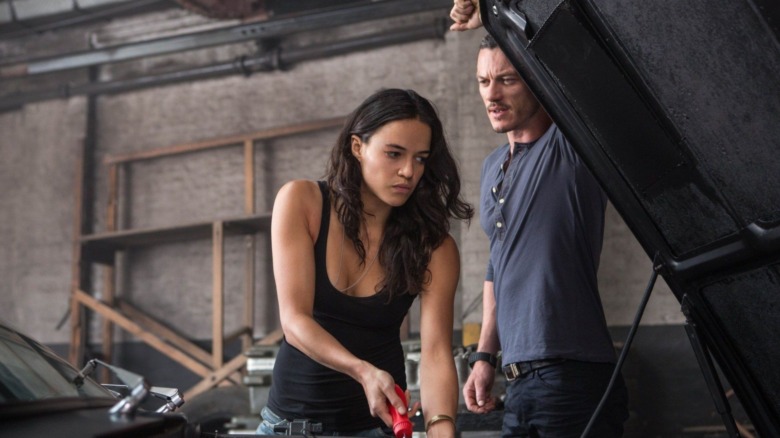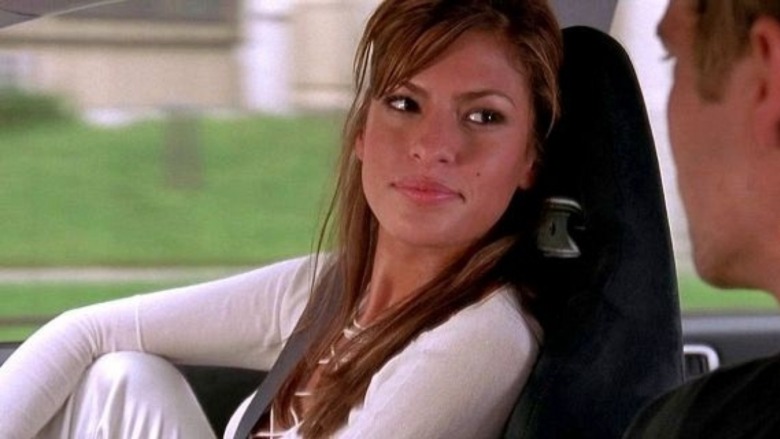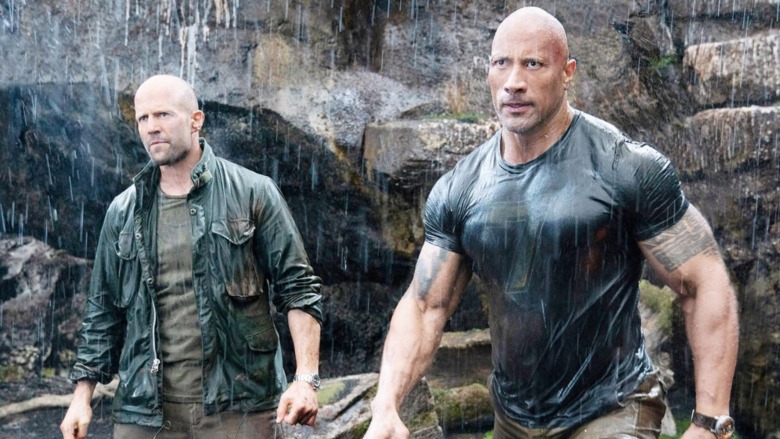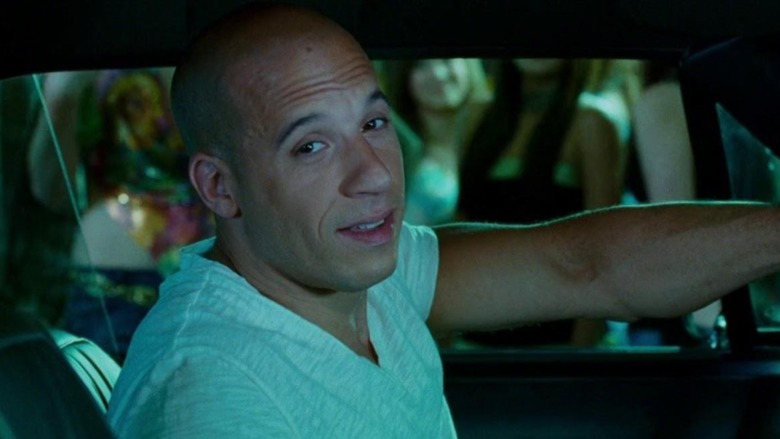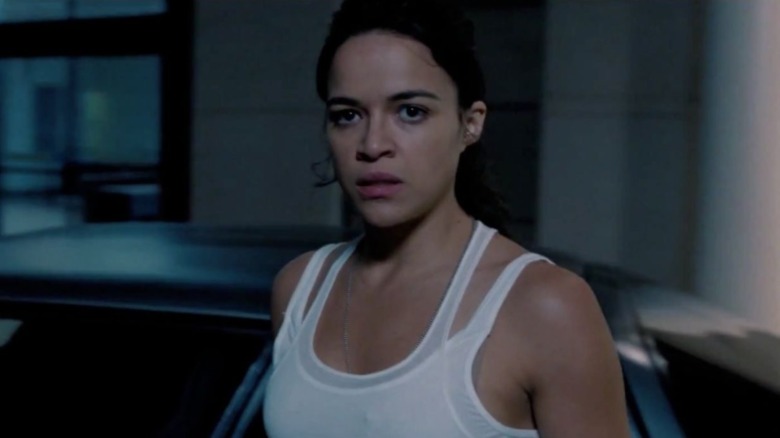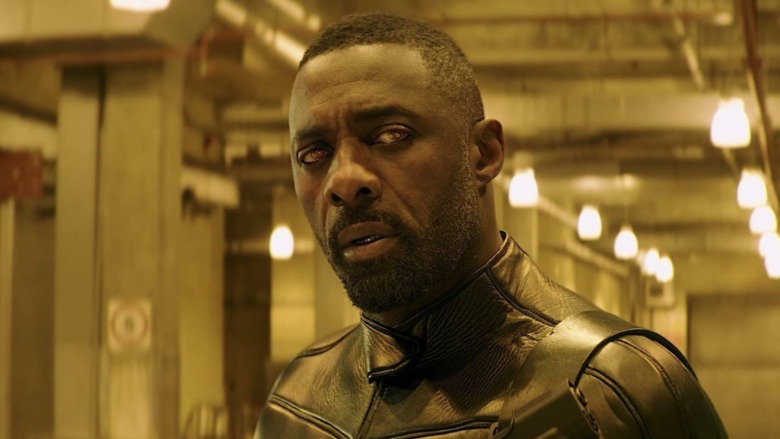Questionable Things In The Fast And Furious Movies We All Ignore
It's become a cliché at this point to say that the "Fast & Furious" movies feature stunts and instances of spectacle that strain credibility. In fact, it's safe to say that such moments have become part of the appeal of this series. Audiences around the world line up to see what over-the-top shenanigans Dominic Toretto (Vin Diesel) and company will get into, resulting in stunts that inspire viewers to simultaneously go "What? How?" and "Woo-hoo!' in equal measure. The ludicrousness (no pun intended) is part of the package, not a defect. Still, there are parts of this sprawling saga that err on the wrong kind of questionable. It's one thing to stretch believability in the service of an exciting set piece. It's another to engage in clumsy storytelling just because it's the easier thing to do.
Some of the more puzzling moments of "Fast & Furious" include bizarre overhauls in the entire personalities of certain characters, as well as unsatisfying explanations for how major figures return from the dead. By and large, such issues have been ignored by the general public, who've found that the thrilling ends of these movies justify the sometimes ham-fisted means of getting there. But even after delivering all those cool car stunts, it's time to look back at the more questionable yet under-discussed parts of the "Fast & Furious" mythos.
Why did Deckard Shaw get to join Dom's family?
"Fast & Furious 6" ends with a bang by revealing that Deckard Shaw (Jason Statham) was the one responsible for killing Han (Sung Kang) in "Tokyo Drift." With this action, the character's intimidating nature was solidified. From there, Shaw caused all kinds of problem for Dominic Toretto and his surrogate "family," including blowing up Toretto's home. By the end of "Furious 7," the gang's most ruthless adversary had finally been defeated, seemingly putting an end to his influence on the lead characters of "Fast & Furious."
Except "The Fate of the Furious" decided to go in the direction of making him an ally to the team as they took on a new villain, Cipher (Charlize Theron). By the film's end, Shaw wasn't just a helpful colleague — he and his own brother, former baddie Owen Shaw (Luke Evans), were saving Toretto's kid from evil henchman. It was strange to see someone responsible for murdering Han getting chummy with Toretto's "family," including for Fast & Furious 6 director Justin Lin. "Somebody asked me about Han and [Deckard] Shaw. I was like, 'Wait, what? Shaw is at the barbecue in 8?'" Lin recalled (via Cinema Blend). "Really, I was so confused. One of the big reasons to come back [to direct F9] was I felt like we needed to correct something." If even one of the main directors of the "Fast & Furious" franchise is puzzled by this development, then maybe Shaw shouldn't be a part of the family.
Roman Pearce's personality drastically changes over the Fast & Furious franchise
Though Brian O'Connor (Paul Walker) returned from "The Fast and the Furious" to headline "2 Fast 2 Furious," Dominic Toretto did not. This meant the square-jawed law enforcement officer needed an experienced rebel to bounce off of. Enter Roman Pearce (Tyrese Gibson), who had a more jovial personality than Toretto from the start and was clearly around to help maintain the buddy-buddy dynamic of the first movie. But while he delivers his share of comedic lines throughout the film, Pearce is not at all supposed to inhabit the archetype of comic relief here.
When "Tokyo Drift" opted to focus on entirely new characters, both O'Connor and Pearce were put on the backburner. In fact, Pearce disappeared from the franchise before finally returning nearly a decade after his first appearance in "Fast Five." This time around, though, Toretto and O'Connor were firmly in the lead roles again, meaning Pearce wasn't needed to fulfill his original job as O'Connor's new partner. But since he had to fill out a new niche, Pearce has taken on the role of the franchise's comic relief, which has required the character to act drastically different than when he first showed up in "2 Fast 2 Furious." While this new personality has allowed Pearce to stick around as a prominent fixture of the "Fast & Furious" universe, it does make the character wildly inconsistent between his debut appearance and his later escapades in the franchise..
Tokyo Drift doesn't really fit in the Fast & Furious timeline
When "The Fast and the Furious: Tokyo Drift" hit theaters in June 2006, it wasn't meant to be something significant in the franchise. It was an attempt to try something new and see if the series could extend beyond Brian O'Connor. The filmmakers certainly weren't thinking about it factoring into an insanely convoluted timeline in one of the biggest action franchises ever made. As a result, the use of flip phones, the car models, and even the presence of Bow Wow in the film's cast all pointed to "Tokyo Drift" being firmly set in the year 2006. However, this would get extra complicated as the "Fast & Furious" franchise eventually opted to retcon "Tokyo Drift" as happening far further in the future.
In 2013, Han's death in "Tokyo Drift" was established as having taken place right after the events of "Fast & Furious 6." Meanwhile, "Furious 7" followed up on Toretto's brief cameo in the third film by having it revealed that he wanted to talk to "Tokyo Drift" protagonist Sean Boswell about Han. Suddenly, a movie previously supposed to take place in 2006 was now rooted in 2015, nearly a whole decade after it was initially released. Trying to flip the timeline of the "Fast & Furious" universe like this was almost audacious enough to be admirable. However, it definitely made the mythos of a series about vehicles zooming by really fast even more difficult to follow.
We're questioning everything about Letty's death
In "Fast & Furious," Letty (Michelle Rodriguez) is murdered, which is a tragic development for Dom and a puzzling one for the franchise. After all, Letty hadn't been a part of the series since the original "Fast and the Furious," and now she was suddenly dead. However, the post-credits scene of "Fast Five" shows that Letty has taken a cue from Mark Twain in that the rumors of her death are greatly exaggerated. In the next movie, "Fast & Furious 6," Letty is not only confirmed to be alive, but she's also shown to be working for the movie's principal foe, Owen Shaw, who apparently rescued her when she was nearly dead. Oh, and she's also got amnesia, which means she has no remorse about working for Shaw or shooting at her boyfriend.
Letty's death and resurrection is a puzzling story turn for the series on a number of levels, particularly in the awkward way the "Fast & Furious" movies refuse to give a more detailed explanation for how exactly she survived. The fact that her amnesia is only sporadically referenced in "Furious 7" and barely mentioned in "The Fate of the Furious" is also strange, especially as it makes her heel turn in "Fast & Furious 6" feel extra superfluous. Audiences come to these movies for the ridiculous, there's no question about that. But going this route with handling the death and revival of a franchise fixture like Letty feels one degree too far from even this saga's level of believability.
The whole Elena saga is really awkward
Elena Neves (Elsa Pataky) isn't one of the most famous "Fast & Furious" characters, but she has one of the strangest plotlines in the entire franchise. First introduced in "Fast Five" as aligned with Luke Hobbs (Dwayne Johnson), thus making her an adversary for the principal characters, she's eventually shown to be dating Dominic Toretto at the start of "Fast & Furious 6." Her status as Toretto's new love interest isn't long for this world, though, as Letty comes roaring back into the series with this same movie. Afterwards, in "Furious 7," Elena is shown working alongside Luke Hobbs once again, and there are even hints that a relationship could be forming between the two. Their bond is reinforced by how she's tasked with taking care of his daughter.
All of those plotlines vanish in "The Fate of the Furious," when Elena is suddenly brought back to the forefront of the continuity as the mother of Toretto's child. All her progress as a character independent of Dom from "Furious 7" vanishes, and suddenly, she's the mother of his newborn baby. There are a lot of questionable aspects about this plot detail, including how the timeline doesn't quite add up (Toretto and Elena's kid should be much older than a newborn considering when they last were intimate) and how all of this feels totally out of character for Elena. And then, her quick death caps off one of the most bafflingly executed plotlines in a series not short on strange narrative detours.
Where did Eva Mendes go?
The "Fast & Furious" movies aren't as famous as the Marvel Cinematic Universe films for their post-credits scene, but "Fast Five" features a moment worth sticking through the credits for. Here, Luke Hobbs is informed by "2 Fast 2 Furious" character Monica Fuentes (Eva Mendes) that Letty is alive and well, despite dying in "Fast & Furious." Not only did this sequence indicate that a franchise staple was getting resurrected, but it indicated that Fuentes was due to reappear in the "Fast Saga" after previously only appearing in the second film. In that earlier movie, Fuentes was a U.S. custom agents whose primary purpose in the plot was to fall in love with Brian O'Connor and to be a damsel-in-distress who could get rescued by the male protagonists during the climax.
Fuentes returning to this series opened the door for Mendes to play a more active character. However, "Fast & Furious 6" failed to follow up on this tease of her returning. And since then, there have been no further appearances by Fuentes. This is likely partially due to Eva Mendes taking a self-imposed sabbatical from acting, but it's still strange that "Fast Five" teed up a return for Monica Fuentes that's yet to pay off, all while bringing back other characters from early movies. Perhaps that prospective female-led "Fast & Furious" spinoff can finally give Fuentes a new adventure to embark on that's more substantive than a post-credit sequence.
Why did Hobbs and Shaw revert back to being enemies?
Prior to the release of "The Fate of the Furious," rumors spread that the characters of Luke Hobbs and Deckard Shaw were being primed for their own spinoff movie. This was teed up in "The Fate of the Furious," which saw the duo being incarcerated together at the same prison. During this fantastic action sequence, they engaged in a scuffle during a prison breakout before being forced to work together to take down Cipher. And over the course of the story, Hobbs and Shaw did grow closer, to the point that they shared a laugh together and were even depicted mingling at Dom's barbeque during the film's closing scene.
Once that spinoff got off the ground in the form of "Hobbs & Shaw," though, a curious thing happened. Suddenly, the two were no longer buddies. At the start of the movie, they were recruited by their respective governments to save the world, and there was an immediate animosity between the duo. Rather than being friendly, they were now inhabiting a classic buddy cop dynamic as they aimed a slew of jokes at one another, taking shots at qualities they hated about one another. It was like they automatically reverted to their dynamic from the start of "The Fate of the Furious" without any consideration for how that rapport had evolved once they left the slammer. "Hobbs & Shaw" featured many stunts that strained credulity, but the awkward way the two leads reverted to an exclusively antagonist dynamic was especially weird.
What's up with Dominic Toretto's absence in 2 Fast 2 Furious?
When "The Fast and the Furious" hit theaters in 2001, a big takeaway for general moviegoers was the present of Vin Diesel. With his gravely voice and a believable sense of authority, Diesel wasn't your average movie star. So it seemed like a no-brainer to bring him back for the inevitable sequels. However, when "2 Fast 2 Furious" was released, Diesel was nowhere to be found, even as fellow original lead Paul Walker was back in the driver's seat.
It was a puzzling move for the franchise, and in the sequel, the absence is chalked up to Toretto being on the run from the law. In the context of the real world, though, it was due to Vin Diesel both having qualms with the script for "2 Fast 2 Furious" and having a desire to break away from the franchise to do "The Chronicles of Riddick" instead. This decision allowed Diesel to follow his own creative pursuits, but it did result in the baffling sight of seeing a "Fast & Furious" movie not headlined by the actor most associated with this franchise. This trait has only gotten more puzzling as the years go by and Diesel remains more and more of a fixture of this saga.
Let's talk about the rampant use of fridging in the Fast & Furious movies
The "Fast & Furious" franchise has a decidedly old-school style of storytelling that largely eschews any modern "grim and gritty" sensibilities. Instead, these films embrace silly spectacle, with villains always seconds away from twirling their mustaches. One downside of this storytelling approach is how these films have a recurring problem with "fridging" women, a practice referring to killing off female characters to motivate male characters.
It's a storytelling device that's unfortunately been around for decades, but the "Fast & Furious" saga keeps engaging with it to a puzzling degree. First, Letty perished in "Fast & Furious" to provide motivation for Dominic Toretto, then Gisele Yashar (Gal Gadot) died during the climax of "Fast & Furious 6" to help push Han to give up being a part of Toretto's crew. Most insulting of all is Elena in "The Fate of the Furious." She's abruptly reintroduced into the saga, only to be quickly killed off so that Toretto has motivation to be mad at the film's baddie, Cipher — as if Cipher forcing Toretto to turn against his family wasn't motivation enough!
The "Fast & Furious" movies keep coming up with over-the-top notions for how to use cars to save the world. However, this same series proves far less imaginative when it comes to figuring out ways to motivate male characters that don't reduce the women to being just corpses.
How to defeat Brixton Lore
Brixton Lore (Idris Elba) is the most advanced adversary to ever appear in a "Fast & Furious" movie. He isn't just ruthlessly violent — he's also outfitted with cyborg enhancements. The first explicitly sci-fi character in the "Fast & Furious" mythos isn't someone you can take down with ease. So considering the leads of "Hobbs & Shaw" are just normal human beings (albeit ones played by Dwayne Johnson and Jason Statham), you'd think it would take a super complicated tactic to defeat Lore and save the world.
So what's the kryptonite of this self-proclaimed Black Superman? Well, as "Hobbs & Shaw" reveals ... he can't fight two people when they attack him at the same time. Yeah, seriously. A maneuver the T-800 could pull off with ease in the first "Terminator" is way too advanced for the most high-tech cyborg to ever exist. It's a ridiculous plot turn meant to be the culmination of a movie where the two leads can't stand each other. Of course the resolution to defeating Lore would lie in cooperating with one another. Still, even for a "Fast & Furious" movie, this tactic for bringing down the baddie is pretty darn questionable.
